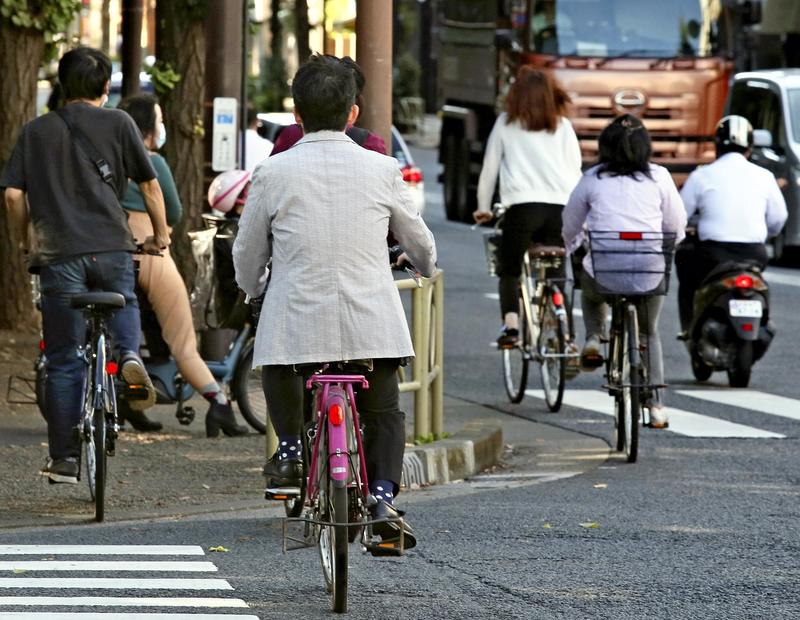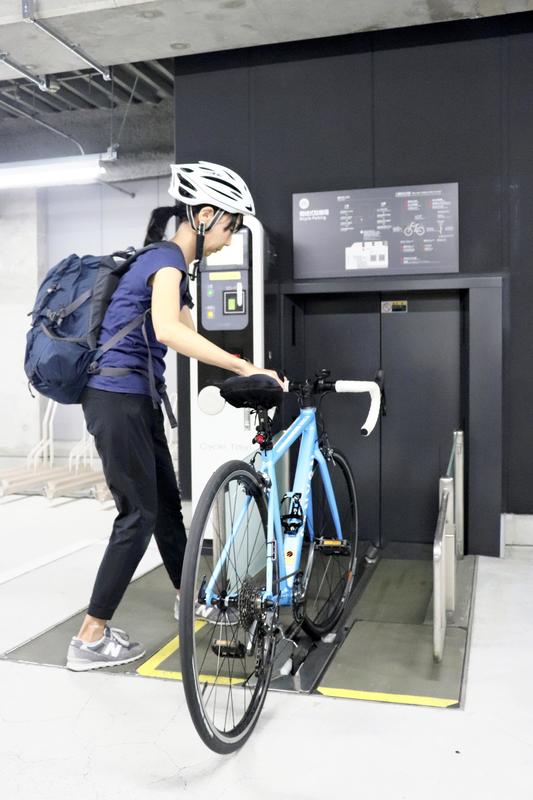
Call it pedal power. An increasing number of people are bicycling to work in recent months to steer clear of getting infected on crowded trains and buses during the coronavirus pandemic.
However, companies embracing this old-fashioned mode of transportation are facing several hurdles. For this shift to be successful down the road, several issues will need to be addressed. For one, accidents happen. The number of people who have bicycle accident insurance will need to increase. Also, more bike parking spaces will be necessary, and bicycle lanes must be developed.

-- Shifting gears
In the basement levels of a 31-story office building in Otemachi, in Tokyo's Chiyoda Ward, there is a multistory bicycle parking lot that can accommodate more than 700 bikes. The elevators are large enough to handle the two-wheelers. The number of people using this bike parking area has been increasing since the spring, when the coronavirus was spreading rapidly. According to Mitsubishi Jisho Property Management Co., the company that operates this lot, the number of registered users has been steadily rising. In January, there were 474. By April, there were 567. And in September, the number reached 622.
A woman who lives in Edogawa Ward started commuting to work by bike in September. The woman, 38, is a lawyer and admitted that she does have some trouble changing from casual clothes into a suit in the bathroom at her office. However, she's fine with that. "I have not only been released from the ordeal of riding jam-packed trains in the morning, but I can also avoid closed and confined spaces," she said with a smile.
A male office worker, 48, who lives in Setagaya Ward, expressed a sense of security. "I switched to commuting to work by bike in March. And, the number of days I work from home has increased. I go to the office only once or twice a week now, but it's still too scary to commute to work by train," he said.
Works Human Intelligence Co., a tech firm, conducted a poll of 146 major corporate clients in February and found that 19.2% of companies allowed employees to commute by bicycle, while 69.9% were not considering the option. When a similar poll covering 152 corporate clients was done in May, the numbers had basically reversed: Those permitting workers to pedal to work reached 51.3%, and those not considering the option had dropped to 35.5%
The poll also found that while some companies do approve of their workers commuting by bicycle, they have not vigorously promoted the idea because there are several stumbling blocks, including the risk of accidents occurring, the need to secure bike parking spaces, and the question of how to factor in commuting expenses.
-- Insurance issues
Techfirm Holdings Inc., an IT company, in July established a system to allow its employees to commute to work by bicycle. "For about a year, requests had been made to allow employees to commute to work by bike, but it was difficult for the company to endorse the idea for several reasons, including the risk of traffic accidents," a company official said. "But, as the need to avoid crowded trains grew amid the coronavirus crisis, we decided to green-light the policy." Techfirm made it mandatory for anyone biking to work to purchase bodily injury liability insurance for 200 million yen or more. To offset this, the company provides them with an allowance of 200 yen per day to cover the insurance expense and to pay for parking.
Employees embraced the idea because it allowed them to minimize the risk of getting infected with the virus. For some, commute times got shorter. Others found the cycling refreshing and energizing.
The need for insurance coverage has risen due to a succession of judicial decisions that have ordered defendants to pay large sums of damage compensation to those who have been victims in bike-related accidents. One suit involved a female pedestrian who was hit by an elementary school child on a bicycle. She later went into a coma. The Kobe District Court handed down a ruling in 2013, ordering reparations of 95 million yen to the victim.
Recently, there has been an increase in the number of local governments that have enacted ordinances making it mandatory for bike users to have bicycle liability insurance for personal and property damages. A total of 13 prefectures including Tokyo, which made such coverage mandatory in April, and seven major cities have established such ordinances.
The Land, Infrastructure, Transport and Tourism Ministry conducted a poll in 2018 and found that in areas where such insurance coverage was obligatory, 60% of bicyclists were insured. In areas without such regulations, only 40% of bike riders were insured.
-- Paving the way
The total length of roads and paths for exclusive bicycle use, such as bike lanes that are separate from pedestrian sidewalks, stood at 2,930 kilometers across the country as of the end of March. In attempts to reduce traffic accidents involving bicycles, the central and local governments have been developing such bike paths. Within central Tokyo, bike lanes on national and major metropolitan roads will be extended by 17 kilometers this fiscal year. Governments around the country are expected to roll out more bike paths and lanes as well.
The transport ministry has launched a project for companies to announce that they endorse bicycling to work. So far, the ministry has recognized 27 companies and organizations as "enterprises that have declared" that they meet the three requirements for certification. The conditions are: securing bike parking spaces for employees, holding a traffic safety course once a year, and making it mandatory for those who commute by bike to have bicycle accident insurance. Companies believe this policy enhances their corporate image.
One of the companies that have signed up is Rakuten, Inc. "By promoting this policy, we show that we are committed to the health of our employees. Also, we agree to the idea of encouraging commuting by bike amid the coronavirus pandemic," a public relations official at Rakuten said.
Various efforts in both the public and private sectors will be essential to improve the environment surrounding bicycle commuting.
-- More people pedaling
According to the Japan Bicycle Promotion Institute, the number of bicycles owned by Japanese people has gradually increased since the end of World War II. Because of a bike boom and the oil crisis in the early 1970s, the number of bicycles soared from about 29 million units in 1970 to 39 million units in 1973.
In the wake of the Great East Japan Earthquake in 2011, people rediscovered the practicality of bikes when public transportation systems suspended operations over a wide area. In 2013, there were 71.55 million bikes in Japan, beating the previous high set in 2006.
Asahi Co., a leading bicycle retailer, saw its April and May sales fall short of figures in the same period in 2019. In the spring, many areas around the country declared a state of emergency. In response, a number of Asahi retail stores suspended business operations, and consumers practiced self-restraint. But from June through August, sales were brisk, with year-on-year increases of 30% to 40%. From March onward, sales are up 15% compared to last year.
Asahi sees the increase in demand as solid. "Early spring was a difficult time for us, but since then, people have seen the utility of bicycles as a means of transportation. Also, with kids playing outdoors, sales of children's bikes have been brisk," an official at the company said.
A leading manufacturer of bicycles, Bridgestone Cycle Corp., has also seen an increase in sales. From May through August, sales were up 10% from the same period last year.
A few potholes to fix aside, the road ahead for two-wheeled power looks smooth as more people embrace the bicycle as a mode of transportation.
Read more from The Japan News at https://japannews.yomiuri.co.jp/







